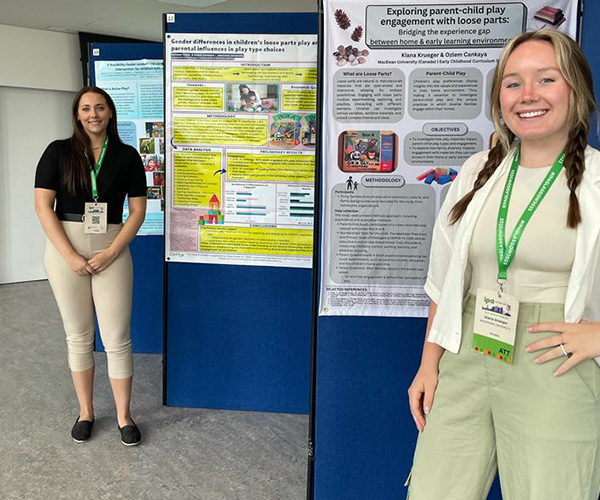What happens when parents swap out their child’s shiny, colourful, plastic toys for random bits and pieces they can find in their backyard or junk drawer? That’s what Courtney Smith and her faculty mentor Dr. Ozlem Cankaya want to find out.
Smith, who just finished her third year in the Bachelor of Early Childhood Curriculum Studies program, is part of Dr. Ozlem Cankaya’s research lab. Together with a team of undergraduate research assistants, she is looking at how children play with their parents using different materials – particularly loose parts.
The theory of loose parts, first introduced by Simon Nicholson in the ‘70s in the context of playground and educational design, focuses on materials that can be combined, taken apart and tinkered with in endless ways. Although the theory has been gaining steam for decades and is touted to have many benefits when it comes to creative and quality play, it has yet to be researched in depth.
So for the past six months, under the guidance of Dr. Cankaya, Smith and her fellow undergraduate research assistants have been busy. They’ve been filling boxes with loose parts, advertising their research project at community party hubs and conducting trials with families to see which materials, including both store-bought and natural or upcycled items – help to facilitate quality play opportunities among parents and young children.
With the data gathering portion of the study now complete, Smith has shifted her focus and is working on analyzing and coding the information they collected – reviewing recordings, transcribing, looking at the types of play they are engaging in and documenting it.
The work is one arm of Dr. Cankaya’s research, which also includes a collection of studies in partnership with colleagues at other universities and community organizations to explore which materials are most conducive to quality play. Their findings can have big implications when it comes to providing empirical evidence for parents, educators and policy-makers making decisions about which materials to integrate into children’s environments.
“I have learned so much and taken on more work than I ever considered I would be capable of,” says Smith. She adds that the effort that went into balancing a hefty workload has paid back in spades. “There have been so many opportunities that have opened up for me – presenting at Student Research Day and having something new to look forward to and discover every week.”
In October 2023, Smith will also be sharing her research at the Society for Study of Human Development’s biennial conference in Philadelphia. She says that her research experiences have also shifted her thoughts on her future career. While she isn’t sure exactly what role she might fill – there are so many possibilities – she plans to continue her education and will apply to graduate school in the coming months.
But there is one thing she is sure about.
“I know that I want to continue to advocate for children and the betterment of the early childhood field. A child’s first few years greatly impact their future, and I want to help support children with the best start to life possible.”

